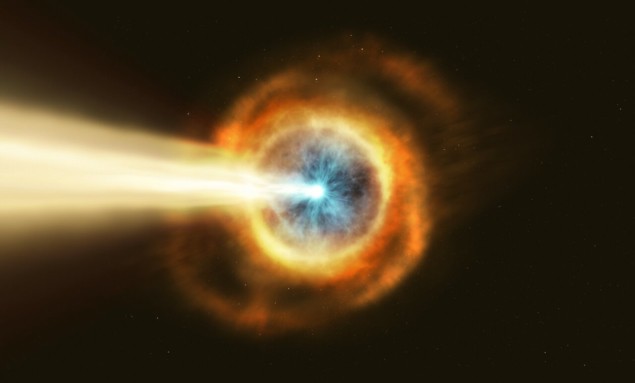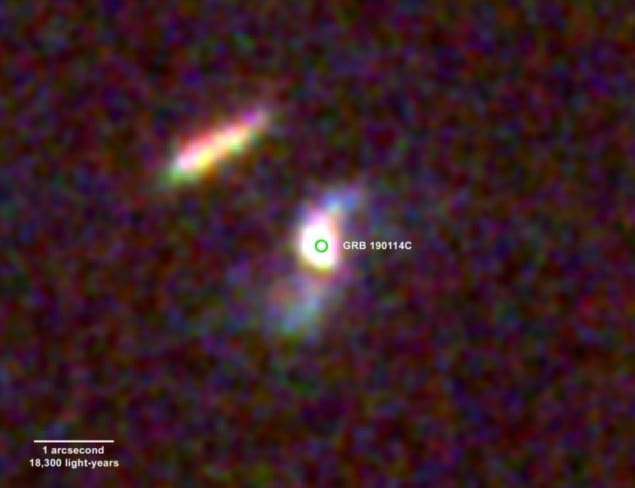
An unusually energetic gamma-ray burst (GRB) has prompted astrophysicists to rethink the role of magnetic fields in these enormous stellar explosions. Observations made in the burst’s immediate aftermath show that key features of its associated magnetic field mysteriously vanished – a phenomenon that cannot be explained by current theories of how such fields form and evolve.
On 14 January 2019, NASA’s early-warning Swift satellite spotted a flash of gamma rays from an exploding massive star in a galaxy 4.5 billion light years away. Such flashes occur when a star’s iron core collapses into a stellar-mass black hole, producing two relativistic beams of strongly-magnetized particles. These beams generate gamma rays through synchrotron radiation, and as they shoot outwards from the collapsing core, the particles in them collide with circumstellar material shed by the star in the run-up to its explosion. The resulting shock creates an optical afterglow that can linger for months.
As soon as Swift detected the burst, which was designated as GRB 190114C, it automatically alerted a host of telescopes on the ground. Within 32 seconds, the MASTER telescopes in the Canary Islands and South Africa were in position and recording the burst’s afterglow.
This fast response has become standard within GRB astronomy, but the data proved anything but. Based on previous observations, astrophysicists expected the afterglow light to be polarized — perhaps by as much as 30 per cent, although the exact figure depends on the strength and structure of the GRB’s magnetic field. The polarimeters on the MASTER telescopes, however, initially measured a polarization of only 7.7 percent. A minute later, when the Liverpool Telescope in the Canary Islands began taking data on the burst, the polarization had dropped to just two percent, and it remained at this marginal level for the remainder of the observations.
That wasn’t the only odd feature about GRB 190114C. When another facility in the Canary Islands, the MAGIC telescopes, began taking data on the afterglow, it measured incredibly energetic emissions – in the tera-electron-volt (TeV) range – from inverse Compton scattering, which occurs when photons collide with electrons in the circumstellar material. This is the first time such emissions have been detected at such high energies in a GRB.
Shock physics

In a paper published today in The Astrophysical Journal, researchers led by Nuria Jordana of the University of Bath, UK, propose a partial solution to the mystery surrounding GRB 190114C. “We speculate that the low polarization is caused by the catastrophic dissipation of magnetic energy, which destroys the order of the magnetic fields and powers the afterglow,” Jordana tells Physics World.
The picture she and her colleagues paint is one of shockwaves bouncing around the circumstellar material. At some point in the 31 seconds before observations began, the blast wave from the stellar explosion struck this material. Pure kinetic energy allowed the jet and much of the forward shock to pummel through, but part of the wave was reflected, forming a so-called reverse shock.
Since localized disturbances scramble the forward shock’s magnetic field in random orientations, the forward shock is never polarized. The reverse shock, however, should still carry the magnetic field ejected by the newly-formed black hole.
In the case of GRB 190114C, something seems to have caused that magnetic field to catastrophically dissipate and dump its energy into the emission from the afterglow – which would explain the unusually high TeV energies. Jordana and colleagues infer that the weak polarization measured between 52 seconds and 109 seconds after the burst was the remnant of the large-scale magnetic field ejected from the black hole.
Looking for causes
The exact cause of the magnetic field collapse remains uncertain. According to Jordana, although the findings hint at a “universal role” for magnetic fields in GRBs, “the survival of the jet’s magnetic field must depend on additional, as yet unknown, physical factors”. She also points out that the polarization of the early optical afterglow has so far been measured in only a handful of GRBs. A larger sample will, she says, be needed to better understand the mechanisms that drive it.

Gamma rays and gravitational lensing provide hints of dark matter
Andrew Levan, an astrophysicist at Radboud University in the Netherlands who co-authored an earlier paper describing the TeV emission, says that the apparent lack of polarization is “a little surprising”, especially given what he describes as the “very early and sensitive observations” of the GRB’s afterglow. Levan’s group found that GRB 190114C occurred in the central region of a galaxy that is interacting with another galaxy – an unusual location, since GRBs tend to be caused by the destruction of massive stars with low abundances of heavy elements, and these are usually only found in less chemically-evolved galaxies. Levan says it’s “plausible” that GRB 190114C’s environment and unusual characteristics could somehow be linked. However, he adds, “it’s a very difficult problem to explain exactly how the field may have collapsed in this case”.



